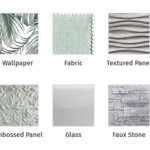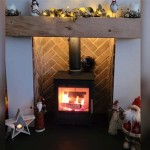Linear Gas Fireplace Designs: A Modern Aesthetic and Efficient Heating Solution
Linear gas fireplaces have emerged as a prominent design element in contemporary residential and commercial spaces. Their elongated, sleek profiles offer a sophisticated visual appeal, complementing minimalist and modern architectural styles. Beyond aesthetics, these fireplaces provide efficient heating and convenient operation, making them a desirable alternative to traditional wood-burning fireplaces. This article will delve into the various aspects of linear gas fireplace designs, exploring their features, installation considerations, and benefits.
The defining characteristic of a linear gas fireplace is its horizontal shape, often spanning several feet in length. This design creates a visually striking focal point, drawing the eye and adding a sense of spaciousness to a room. The flame presentation is typically uninterrupted, offering a panoramic view of the fire. Linear fireplaces can be installed in a variety of settings, including living rooms, bedrooms, and even outdoor areas, providing versatility in design implementation.
The fuel source for these fireplaces is natural gas or propane, offering a clean and efficient burning process. Many models are equipped with advanced burner systems that create realistic-looking flames, mimicking the appearance of a traditional wood fire. Remote control operation is a common feature, allowing users to adjust the flame height, temperature, and even activate timers for automated operation. The integration of safety features, such as automatic shut-off mechanisms, ensures safe and reliable use.
Aesthetic Versatility and Customization Options
One of the primary appeals of linear gas fireplaces lies in their aesthetic versatility. The long, horizontal form factor allows for a wide range of design integration possibilities. They can be installed flush with the wall for a seamless, minimalist appearance, or they can be incorporated into custom-built surrounds featuring materials such as stone, tile, or wood. The aesthetic flexibility extends to the firebox itself. Many models offer customizable options for the media used within the fireplace, ranging from traditional logs to modern glass beads or stones. These design choices allow you to tailor the fireplace to complement the specific style of the room.
Furthermore, the firebox interiors are often designed with reflective materials that enhance the flame's visibility and create a more visually dynamic presentation. The use of LED accent lighting within the firebox can further accentuate the flames and add a touch of modern sophistication. The glass fronts on linear fireplaces are typically made of high-temperature ceramic glass, providing a clear view of the flames while ensuring safety. Some models offer options for single-pane or double-pane glass, with double-pane glass providing enhanced insulation and reduced surface temperatures.
The placement of a linear fireplace is equally important in achieving the desired aesthetic. They are frequently installed below televisions, creating a unified focal point in the room. However, it is crucial to consider the heat output of the fireplace and the manufacturer's recommendations regarding clearance distances to ensure the safe operation of electronic devices. Alternatively, linear fireplaces can be installed as room dividers, creating a visual separation between spaces while providing warmth and ambiance to both areas.
Installation Considerations and Technical Specifications
The installation of a linear gas fireplace is a complex process that requires careful planning and adherence to local building codes and manufacturer's instructions. It is strongly recommended that a qualified and licensed gas fitter perform the installation to ensure safety and compliance. The first step in the installation process is to determine the appropriate location for the fireplace, taking into account factors such as venting requirements, gas line access, and electrical connections.
Venting is a critical aspect of gas fireplace installation. Linear fireplaces typically require direct-vent systems, which exhaust combustion gases directly to the outside through a sealed vent pipe. Direct-vent systems offer enhanced safety and efficiency compared to traditional chimney systems. The vent pipe can be run horizontally through a wall or vertically through the roof, depending on the specific model and installation requirements. The length and configuration of the vent pipe must comply with the manufacturer's specifications to ensure proper venting and prevent the buildup of carbon monoxide.
Gas line access is another essential consideration. A gas line must be run to the fireplace location, and a shut-off valve should be installed for safety. The size of the gas line must be adequate to supply the fireplace with the required gas pressure. Electrical connections are also necessary to power the fireplace's control system, blower (if equipped), and accent lighting. A dedicated electrical circuit is typically recommended to prevent overloading the circuit.
Prior to installation, it is important to consult with a structural engineer to ensure that the existing structure can support the weight of the fireplace and its surround. Reinforcement may be necessary, particularly for larger fireplaces or those installed on upper floors. The installation process typically involves framing the fireplace opening, installing the vent pipe, connecting the gas line and electrical connections, and finishing the surround with the chosen materials. Regular maintenance, including cleaning the glass front and inspecting the venting system, is essential to ensure the safe and efficient operation of the fireplace.
Benefits of Linear Gas Fireplaces: Efficiency, Convenience, and Environmental Considerations
Linear gas fireplaces offer a range of benefits compared to traditional wood-burning fireplaces. One of the primary advantages is their energy efficiency. Gas fireplaces typically have higher efficiency ratings than wood-burning fireplaces, meaning that a greater percentage of the fuel's energy is converted into heat. This translates into lower heating costs and reduced energy consumption. Many linear gas fireplaces are equipped with features such as programmable thermostats and remote control operation, allowing users to precisely control the temperature and heating schedule, further optimizing energy efficiency.
Convenience is another significant benefit. Unlike wood-burning fireplaces, gas fireplaces require no wood storage, chopping, or hauling. They ignite instantly with the push of a button or the flip of a switch, providing immediate warmth and ambiance. There is no need to tend to the fire or clean up ashes. Remote control operation allows users to adjust the flame height and temperature from the comfort of their couch. The ease of use and convenience of linear gas fireplaces make them an attractive option for busy homeowners.
Environmental considerations are also a factor in the growing popularity of linear gas fireplaces. Gas fireplaces produce significantly fewer emissions than wood-burning fireplaces. The combustion of natural gas or propane releases less particulate matter and greenhouse gases into the atmosphere. Direct-vent systems further minimize emissions by ensuring that combustion gases are properly vented to the outside. While gas is still a fossil fuel, the reduced emissions compared to wood-burning make linear gas fireplaces a more environmentally friendly heating option. Furthermore, the use of renewable natural gas (RNG) or propane can further reduce the environmental impact of gas fireplaces.
In summary, linear gas fireplaces offer a compelling combination of aesthetic appeal, energy efficiency, convenience, and environmental benefits. Their sleek designs and customizable options make them a versatile choice for modern residential and commercial spaces. While installation requires careful planning and professional expertise, the long-term benefits of a linear gas fireplace make it a worthwhile investment for those seeking a stylish and efficient heating solution.

2024 Gas Fireplace Trends Design Regency

Enviro S Gas C72 Linear Fireplace

55 Contemporary Linear Fireplace Ideas For Every Home Gas Modern Houses Interior

C60 Tall Linear Gas Fireplace Stamford Fireplaces

Fireplace Design Ideas Exemplar Inspiration On Houzz Montigo

Linear Gas Fireplaces Valor

Gas Fireplaces Premium Linear By Lopi Selector

The Key Benefits Of A Modern Linear Gas Fireplace Embers Fireplaces Outdoor Living

Linear Fireplace Ideas And How To Make Them Work

Why Get A Linear Fireplace How Can Change Your Room
Related Posts








